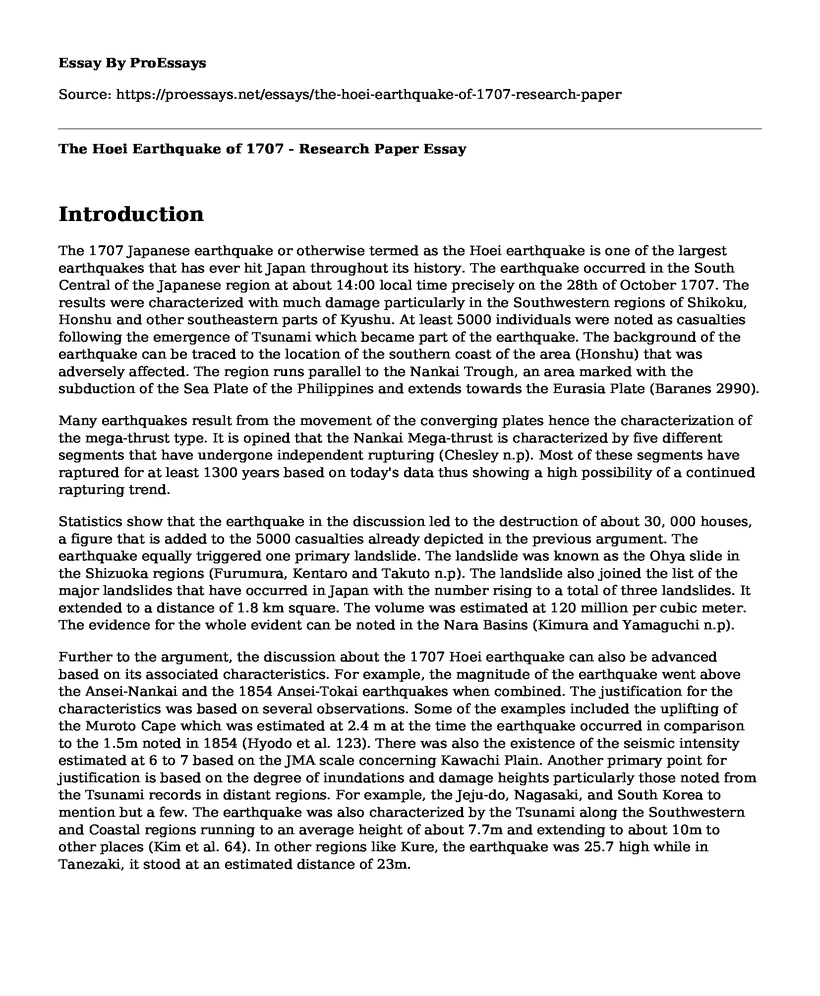Introduction
The 1707 Japanese earthquake or otherwise termed as the Hoei earthquake is one of the largest earthquakes that has ever hit Japan throughout its history. The earthquake occurred in the South Central of the Japanese region at about 14:00 local time precisely on the 28th of October 1707. The results were characterized with much damage particularly in the Southwestern regions of Shikoku, Honshu and other southeastern parts of Kyushu. At least 5000 individuals were noted as casualties following the emergence of Tsunami which became part of the earthquake. The background of the earthquake can be traced to the location of the southern coast of the area (Honshu) that was adversely affected. The region runs parallel to the Nankai Trough, an area marked with the subduction of the Sea Plate of the Philippines and extends towards the Eurasia Plate (Baranes 2990).
Many earthquakes result from the movement of the converging plates hence the characterization of the mega-thrust type. It is opined that the Nankai Mega-thrust is characterized by five different segments that have undergone independent rupturing (Chesley n.p). Most of these segments have raptured for at least 1300 years based on today's data thus showing a high possibility of a continued rapturing trend.
Statistics show that the earthquake in the discussion led to the destruction of about 30, 000 houses, a figure that is added to the 5000 casualties already depicted in the previous argument. The earthquake equally triggered one primary landslide. The landslide was known as the Ohya slide in the Shizuoka regions (Furumura, Kentaro and Takuto n.p). The landslide also joined the list of the major landslides that have occurred in Japan with the number rising to a total of three landslides. It extended to a distance of 1.8 km square. The volume was estimated at 120 million per cubic meter. The evidence for the whole evident can be noted in the Nara Basins (Kimura and Yamaguchi n.p).
Further to the argument, the discussion about the 1707 Hoei earthquake can also be advanced based on its associated characteristics. For example, the magnitude of the earthquake went above the Ansei-Nankai and the 1854 Ansei-Tokai earthquakes when combined. The justification for the characteristics was based on several observations. Some of the examples included the uplifting of the Muroto Cape which was estimated at 2.4 m at the time the earthquake occurred in comparison to the 1.5m noted in 1854 (Hyodo et al. 123). There was also the existence of the seismic intensity estimated at 6 to 7 based on the JMA scale concerning Kawachi Plain. Another primary point for justification is based on the degree of inundations and damage heights particularly those noted from the Tsunami records in distant regions. For example, the Jeju-do, Nagasaki, and South Korea to mention but a few. The earthquake was also characterized by the Tsunami along the Southwestern and Coastal regions running to an average height of about 7.7m and extending to about 10m to other places (Kim et al. 64). In other regions like Kure, the earthquake was 25.7 high while in Tanezaki, it stood at an estimated distance of 23m.
Conclusion
In summary, the 1707 Hoei earthquake appears as one of the largest earthquakes in Japanese history until 2011 when the Tohoku earthquake occurred. The destruction was characterized by severe damage registered in at least three regions. The Shikoku, the Honshu, and the Kyushu. An estimated 30,000 houses were destroyed coupled with at least 5000 casualties. My take for the earthquake follows its connection to the Mount Fuji eruption and the Tsunami factor hence the high number of casualties and immense destructions.
Works Cited
Baranes, Hannah, et al. "Interseismic CouplingBased Earthquake and Tsunami Scenarios for the Nankai Trough." Geophysical Research Letters 45.7 (2018): 2986-2994.
Chesley, Christine, et al. "The 1707 Mw8. 7 Hoei earthquake triggered the largest historic eruption of Mt. Fuji." Geophysical Research Letters 39.24 (2012).
Furumura, Takashi, Kentaro Imai, and Takuto Maeda. "A revised tsunami source model for the 1707 Hoei earthquake and simulation of tsunami inundation of Ryujin Lake, Kyushu, Japan." Journal of Geophysical Research: Solid Earth 116.B2 (2011).
Hyodo, Mamoru, et al. "The possibility of the deeper or shallower extent of the source area of Nankai Trough earthquakes based on the 1707 Hoei tsunami heights along the Pacific and the Seto Inland Sea coasts, southwest Japan." Earth, Planets, and Space 66.1 (2014): 123.
Kim, SatByul, et al. "The Nankai Trough earthquake tsunamis in Korea: numerical studies of the 1707 Hoei earthquake and physics-based scenarios." Earth, Planets, and Space 68.1 (2016): 64.
Kimura, Gaku, and A. Yamaguchi. "Upper Plate hysteresis controlling seismogenic rupture area, slow slip area in Subduction Zone; an example from the Nankai Trough." AGU Fall Meeting Abstracts. 2017.
Cite this page
The Hoei Earthquake of 1707 - Research Paper. (2022, Dec 17). Retrieved from https://proessays.net/essays/the-hoei-earthquake-of-1707-research-paper
If you are the original author of this essay and no longer wish to have it published on the ProEssays website, please click below to request its removal:
- The Future Power System - Essay Sample
- Life During the Four Eras Processes of Fossilization Paper Example
- Paper Example on Exxon Valdez Oil Spill
- Case Study on MHE509 SLP 3
- Essay Example on Tech Advances: Sustainable Growth or Unsustainable Destruction?
- Article Analysis Essay on Wastewater Reuse for Irrigation: Nutrient Recovery & Waste Disposal
- Reviewing Waste Management's Cash Flows - Essay Sample







